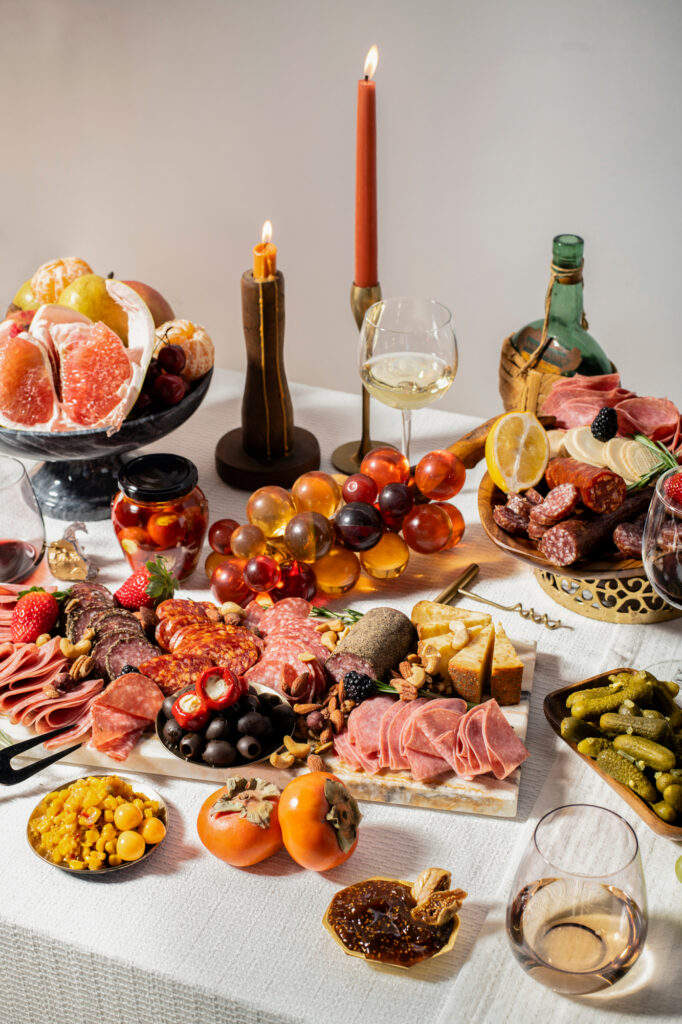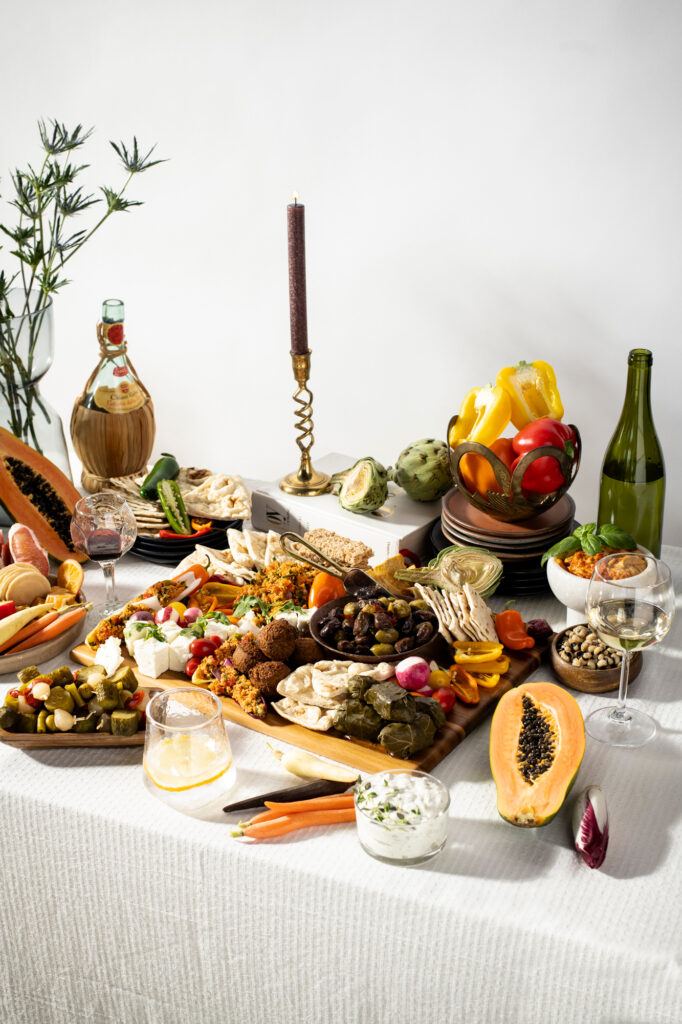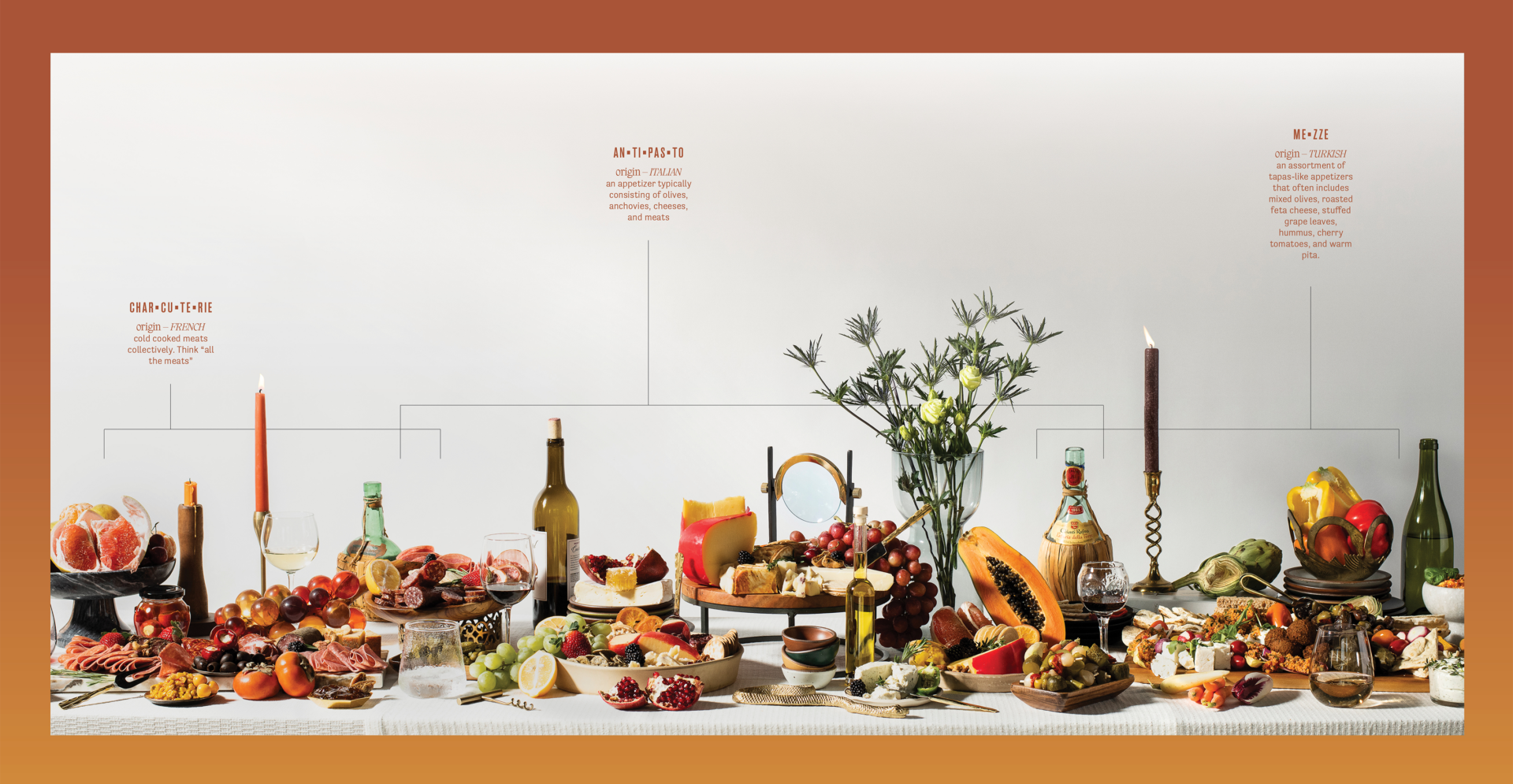Photography by Jason Stephens
Prop Styling by Lisa Malott
Master the art of mixing and matching ingredients to create unique flavor profiles and a variety of textures on snack-board assembly, with expert advice from Uli & Co.
 A few years ago, while in Italy, I ordered a charcuterie board, and to my surprise there were cured meats, paté, olives, pickles, bread… and no cheese in sight. I quickly pulled out my phone and Googled “charcuterie.” Pronounced “shar-KOO-tər-ee,” this word comes from the French words chair (“flesh”) and cuit (“cooked”) referring to cooked, cured, or smoked meats and dry-cured sausage. Kind reminder — words have meaning.
A few years ago, while in Italy, I ordered a charcuterie board, and to my surprise there were cured meats, paté, olives, pickles, bread… and no cheese in sight. I quickly pulled out my phone and Googled “charcuterie.” Pronounced “shar-KOO-tər-ee,” this word comes from the French words chair (“flesh”) and cuit (“cooked”) referring to cooked, cured, or smoked meats and dry-cured sausage. Kind reminder — words have meaning.
Charcuterie dates back hundreds of years to the time when Old France was known as Gaul, while the art of preserving meats in a variety of ways dates back thousands of years. These antiquated methods and techniques in which the essential elements of traditional charcuterie boards are made include curing, salting, smoking, and preserving. The meats are often complemented by pickles, olives, whole-grain mustard, and black truffle butter, to name a few.
The modern-day resurgence of charcuterie boards is essential to meals in France, Italy, and the Mediterranean. Although charcuterie boards are not a new thing, they are having a moment right now, especially in America, perhaps because it’s the easiest appetizer to handle at a party in addition to their impressive visual appeal. So much so, that one of the most popular trends amongst the event industry is snack-board styling, ordering, and delivery. For this article, we partnered with one of Lakeland’s top event designers and charcuterie board experts, Uli & Co.
Uli & Co. is owned by mother-and-daughter duo Maria Mironchuk and Julie Czernek. They started the business as a local floral company offering a variety of arrangements and bouquets. Within months they expanded their offerings to balloon arches and most recently snack boards, including charcuterie and cheese, breakfast boards, and everything in between.
“Our first time creating a charcuterie board was because we had a client request,” says Czernek. “At Uli & Co., we always say, ‘If you ask us, we’ll do it. If you want something for your party, we’ll buy it for you.” This approach has given Uli & Co. opportunities to grow in their product offerings, quickly making them your go-to florist, balloon-arch designers, and charcuterie-board stylists.
The preparation of a board begins with choosing the type of board you are creating, finding the right ingredients, and arranging them in color, texture, shape, appearance, and by flavor profile of each element. Uli & Co. prepared three types of boards to guide us with some of the most important tips and tricks for preparing an impressive snack board.

THE MEZZE BOARD
Mezze boards are common throughout the Middle East and Mediterranean. Dips are central to this board, and they tie all the other ingredients together perfectly. Like every good board, the mezze builds on a variety of delicacies according to region, including infused hummus, zesty tabbouleh, falafel, olives, fresh or grilled veggies, salty feta, pickled veggies, grilled pita, dolmas, and creamy tzatziki. One way to make your board special and interesting is to source the best ingredients from specialty markets such as international food stores.
“It’s important to determine the size of the board,” Czernek says. Keep in mind that you want to use pinch bowls for spreads, dips, and other ingredients with juices such as olives to keep your board from getting messy. These items will also help with filling in the space and creating visual interest, especially with larger spreads. During this phase you also want to consider your crowd and opt for a vegetarian or gluten-free board if it makes sense.
“At Uli & Co., we are very accommodating to the needs and orders of our clients when creating a snack board. This means making sure we meet their special requests and dietary restrictions,” says Czernek.

THE CHEESE BOARD
One of the most popular boards are charcuterie-and-cheese boards; however, in this article, we give each of these boards space to highlight their individuality.
Cheese: so many types from which to choose. It’s easy to feel overwhelmed or get carried away when choosing for your cheese board, but remember, the size of the board is key as to how much you will need. Typically, three types of cheese are a good starting point. Choose a soft cheese, hard cheese, and crumbly cheese for diversity in texture and taste.
It’s best to arrange the cheese first by placing it equally spaced across the board. “The great thing about cheese is it can make a statement in several different ways: you can cut it, crumble it, or style it whole for an impressive look,” says Czernek.
“Dips are central to this board, and they tie all the other ingredients together perfectly.”
After arranging the cheese, it’s time to add some accompaniments such fruit, preserves, honey, and crackers. Place the honey and preserves in pinch bowls and set them on the board; then place the fruit around it. When choosing fruit, think seasonally: berries, grapes, figs, and cherries are good summer fruits. Try to avoid anything too messy. Lastly, you want to fill in with crackers, nuts, marcona almonds, and dried berries or apricots.
 A TRADITIONAL CHARCUTERIE BOARD
A TRADITIONAL CHARCUTERIE BOARD
Now that we know exactly what charcuterie means, we can arrange a beautiful, traditional charcuterie board. This one is a meat-lover’s dream. There are several types of meats to choose from for your charcuterie board, from salt-cured sausages like salami, rosette, and chorizo, to smoked hams and dry-cured ham like prosciutto. In addition, if you’d like to keep it really traditional, don’t forget about including a tartine, which is made from a variety of ground meats. Patés, terrines, and rillettes are all tartines and perfect for spreading over bread.
Styling meats can feel intimidating, but a simple video tutorial can go a long way. “Learning how to fold and style charcuterie was an essential part to making a board visually appealing,” explains Czernek. “We watched videos as a starting point, and then over time we developed our own design and figured out what worked for us and our boards.”
Finish off the board with a selection of two to three types of breads such as sourdough, rye, and multigrain. Last, but not least, add in the accents: black, green, and stuffed olives make for great variety; salted nuts; cornichons; radishes; dijon mustard; and butter make great accompaniments for this board.
While all of these are great tips, remember that building a board has no rules; it’s all about you and your guests. And if you’re not into board making or would like to take the pressure off of making one yourself, ordering a snack board from Uli & Co. is the perfect solution for any occasion, including, gift-giving, gatherings, and events.
instagram.com/uli.and.co/
